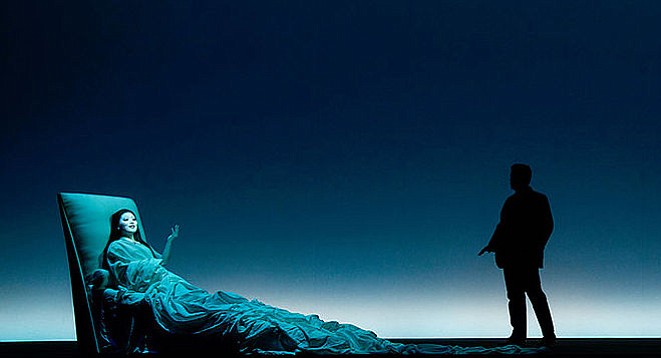 Facebook
Facebook
 X
X
 Instagram
Instagram
 TikTok
TikTok
 Youtube
Youtube

Since La Traviata opened at San Diego Opera on Saturday, April 22, I’m going to use it as an excuse to float a theory about the final lines of the opera.
Just before Violetta dies she has a few lines which might lead us to believe that she is going to make it after all. She says something like, “How strange, my pain is gone. I feel a new vigor. I am returning to life. O Joy!” Then she falls dead.
Here’s my theory. Verdi is trying to create a fey mood. The word fey entered the English language 800 years ago, and one of its meanings is “giving an impression of vague unworldliness.”
Every now and then when a dying person has made her peace she is reported to have an almost supernatural glow which increases as she approaches death. It doesn’t happen with every death, but it is a well known phenomenon. Mother Teresa's nuns, who care for the dying in Calcutta have a saying, "The candle burns brightest before it goes out."
I’m choosing to look at these final lines as if Violetta is already dead when she delivers them. It has been staged this way only once that I can find, and that once would be the Willy Decker production from Salzburg.
Violetta is in the middle of the stage with the figure of death while the rest of the characters are far upstage and already grieving. I found it to be more beneficial than a cheesy staging of Violetta standing up and then falling down dead.
If feels like a cheap trick. Wait, I’m better. No, I’m not. The end.
However, moving the lines into Violetta’s transition takes the campy melodramatic feel out of the equation and replaces it with a more sincere existential statement.
San Diego Opera's La Traviata runs April, 25, 28, and 30..


Since La Traviata opened at San Diego Opera on Saturday, April 22, I’m going to use it as an excuse to float a theory about the final lines of the opera.
Just before Violetta dies she has a few lines which might lead us to believe that she is going to make it after all. She says something like, “How strange, my pain is gone. I feel a new vigor. I am returning to life. O Joy!” Then she falls dead.
Here’s my theory. Verdi is trying to create a fey mood. The word fey entered the English language 800 years ago, and one of its meanings is “giving an impression of vague unworldliness.”
Every now and then when a dying person has made her peace she is reported to have an almost supernatural glow which increases as she approaches death. It doesn’t happen with every death, but it is a well known phenomenon. Mother Teresa's nuns, who care for the dying in Calcutta have a saying, "The candle burns brightest before it goes out."
I’m choosing to look at these final lines as if Violetta is already dead when she delivers them. It has been staged this way only once that I can find, and that once would be the Willy Decker production from Salzburg.
Violetta is in the middle of the stage with the figure of death while the rest of the characters are far upstage and already grieving. I found it to be more beneficial than a cheesy staging of Violetta standing up and then falling down dead.
If feels like a cheap trick. Wait, I’m better. No, I’m not. The end.
However, moving the lines into Violetta’s transition takes the campy melodramatic feel out of the equation and replaces it with a more sincere existential statement.
San Diego Opera's La Traviata runs April, 25, 28, and 30..
Comments